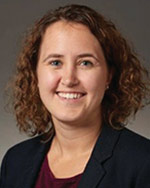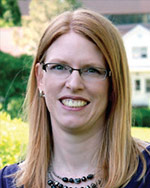Your rural data resources: the people behind the numbers
RHI Hub tweets #RuralHealthNotes as a snapshot resource.
 Diane Calmus  Megan Lahr  Kristine Sande  Shawnda Schroeder |
Research can be a powerful tool that informs decisions and transforms the way we approach health programs and policies — but the numbers don’t always speak for themselves. To help illustrate the unique nature of rural health, we need people to bring those numbers to life and share research findings within the context of real-life experiences and stories. NRHA staff has identified four stakeholders that are on the vanguard of rural health research.
Whether you’re a facility administrator trying to keep up with regulations, a reporter following a story on rural health, a student looking for primary sources, or a researcher writing for grants, the first thing you need is a place to start.
From rural facilities and national quality initiatives to online resources and policy analysis, these clearinghouses offer perspective and experience to help rural health leaders, providers, educators, and students raise awareness, demonstrate needs, and identify solutions that work for their communities.
Rural Health Research Gateway
The Rural Health Research Gateway is a great place to explore quality national research on the most pressing rural health issues. The Gateway provides easy and timely access to all 11 federally funded rural health research centers and analysis initiatives.
“Our research centers have been conducting high-quality research for over 30 years, and through the Gateway, we’re providing a voice for rural communities by promoting the work of the research centers and finding evidence for policy decisions,” says Shawnda Schroeder, PhD, University of North Dakota Center for Rural Health research assistant professor and Rural Health Research Gateway project director.
The Rural Health Research Gateway aims to spread research to all audiences, including policymakers, educators, public health employees, hospital staff, health care providers, and students. “We highlight the research at national conferences and exhibits and invite the centers to host webinars to make the research more tangible. The research is available in an online library and free for anyone to use,” Schroeder says. “Gateway shares contact information for rural health researchers, so you can reach out for more information. This leads to strong collaboration, reduced redundancy, and more opportunities to dig deeper.”
Schroeder partners with other organizations on sharing and linking to relevant information. “We make the information more approachable by providing quick links to key research findings on Facebook, Twitter, and YouTube,” she says.
Connect with the Rural Health Research Gateway:
ruralhealthresearch.org
info@ruralhealthresearch.org
facebook.com/RHRGateway
twitter.com/rhrgateway
Flex Monitoring Team
If you’re looking for research on critical access hospitals (CAHs), the Flex Monitoring Team provides an excellent framework for accessing data.
The Flex Monitoring Team is a collaboration of researchers from the University of Minnesota (UMN), University of North Carolina (UNC) at Chapel Hill, and the University of Southern Maine (USM) operating through a cooperative agreement to monitor and evaluate the Medicare Rural Hospital Flexibility Program, which created CAHs in 45 states.
The UMN team works on quality improvement initiatives; UNC-Chapel Hill measures financial and operational improvement; and USM studies the community impact of population health. “We take a large amount of complex data and compile it into reports and tools for rural health stakeholders to help them make informed decisions to improve their systems,” explains Megan Lahr, MPH, University of Minnesota Rural Health Research Center research fellow and Flex Monitoring Team investigator.
The Flex Monitoring Team provides research, briefs, data reports, and a query tool for CAH administrators and state Flex Program coordinators. Later this spring, state and county quality data for some metrics will be made publicly available.
“We’ve been in the niche area of looking at CAHs for 20 years now, and it’s great to have reliable sources so key stakeholders in rural health know where to go for trusted information. This develops meaningful connections for new research projects and reduces the burden of looking for information. We love staying connected to the folks who are doing the work and hearing from you with questions and feedback,” Lahr says.
Connect with Flex Monitoring Team:
flexmonitoring.org
monitoring@flexmonitoring.org
facebook.com/flexmonitoringteam
twitter.com/flexmonitoring
RHI Hub
Rural Health Information (RHI) Hub provides a broad range of rural health research from multiple sources, as well as guidance to help you find the information that matters most to you. RHI Hub is a national clearinghouse on rural health issues funded by the Federal Office of Rural Health Policy to provide information, opportunities, and resources on rural health.
“The overall purpose of RHI Hub is to help people find information and resources they can use in their work,” says Kristine Sande, MBA, RHI Hub program director. “We’re trying to help level the playing field for rural health organizations, to make them aware of resources that are available to them, to help them find data and information to help them with decision making or grant writing.”
The online library houses thousands of resources from organizations at the federal, state, and county level, including toolkits, program models, statistics, and maps. Newsletters and custom alerts deliver curated resources directly to your inbox.
“The information is valuable when working with a group of stakeholders because it brings together real-world examples that match up with research, and sharing new information sparks important discussions and progress with rural issues,” Sande says. “In addition to finding resources to improve services in your community, RHI Hub helps users stay on top of grant opportunities and connect with others who have expertise in rural health issues.”
Connect with RHI Hub:
ruralhealthinfo.org
info@ruralhealthinfo.org
facebook.com/RHIhub
twitter.com/ruralhealthinfo
NRHA Government Affairs
If you’re looking for more ways to connect the dots between research and legislative and regulatory policy, NRHA’s Government Affairs office serves as the primary resource for elected officials and policy leaders on rural health issues.
“It’s our job to inform Congress and the administration about what is happening in rural America and help shape policies that help rural Americans maintain access to care,” says Diane Calmus, NRHA regulatory counsel. “A part of that is taking key research data and blending that with stories from our members to support our advocacy work.”
One major hurdle is simply getting the information in front of the people who need to see it. “Legislators don’t have time to read a 10-page research paper, so we translate it in an accessible way with one-pagers and infographics,” Calmus says. “We also share the information on Twitter to inform NRHA members about what’s happening on the Hill and give them a call to action.”
NRHA’s advocacy work starts with our membership. “Member engagement is the driving force in everything we do. It all starts with members sharing stories about how public policy is impacting them. This is what gets the attention on the Hill, and research is what helps move it across the finish line. Making those connections is key to moving rural health issues forward,” Calmus says.
Additionally, NRHA’s Rural Health Fellows Program provides an opportunity for participants to engage in yearlong, intensive leadership and advocacy training. Rural Health Fellows may be tasked with pulling together research and communicating their findings.
Connect with NRHA Government Affairs:
Rural health research by the numbers
Rural America may be small in numbers, but we have tremendous support from those who are engaged in the issues and using research to build a stronger future. Here’s a snapshot of rural health research traffic:
- 78,000 page views and more than 24,000 new visitors to the Rural Health Research Gateway website in the past six months.
- 17,000 downloads by more than 36,000 visitors to the Flex Monitoring Team website in the past year.
- 1.2 million visits and 640 requests for customized assistance on the Rural Health Information Hub in the last fiscal year.
